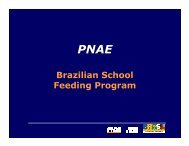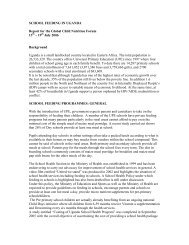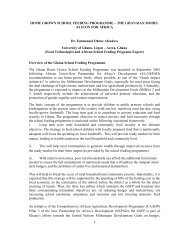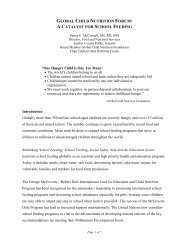Nutritional Status and Problems of School Age Children in Turkey
Nutritional Status and Problems of School Age Children in Turkey
Nutritional Status and Problems of School Age Children in Turkey
You also want an ePaper? Increase the reach of your titles
YUMPU automatically turns print PDFs into web optimized ePapers that Google loves.
<strong>Nutritional</strong> <strong>Status</strong> <strong>and</strong> <strong>Problems</strong> <strong>of</strong> <strong>School</strong> <strong>Age</strong> <strong>Children</strong> <strong>in</strong> <strong>Turkey</strong><br />
Pr<strong>of</strong>. Türkan Kutluay Merdol, PhD, Pr<strong>of</strong>. Gülden Köksal, PhD, Eda Köksal,PhD<br />
Hacettepe University, Department <strong>of</strong> Nutrition <strong>and</strong> Dietetics, Ankara, <strong>Turkey</strong><br />
Introduction<br />
<strong>Turkey</strong> is a democratic republic country located <strong>in</strong> the middle <strong>of</strong> Asia <strong>and</strong> Europe with<br />
a population <strong>of</strong> 72 million (2006 estimation). The percentage <strong>of</strong> 0-14 year old children is<br />
about 29, <strong>and</strong> the school age children (7-14 age) are 15.4 % <strong>of</strong> the total population (1) . The<br />
number <strong>of</strong> school exist<strong>in</strong>g for school age children is 34.990. Some schools have education<br />
whole day (starts at 8 30 or 9 oo am <strong>and</strong> ends at 3 30 or 4 oo pm with an hour lunch break) <strong>and</strong><br />
some have half day program for two shifts a day (mostly 7 45 to 12 45 am <strong>and</strong> 12 45 to 5 45 pm).<br />
There are 582 board<strong>in</strong>g schools for 287.000 students. About 700.000 students are carried to<br />
neighbor<strong>in</strong>g village schools from small habitats by vehicles where day stay whole day <strong>and</strong><br />
receive their lunch packages (2). There are two groups <strong>of</strong> schools <strong>in</strong> <strong>Turkey</strong>, ie. governmental<br />
<strong>and</strong> private. Each has different policy <strong>and</strong> problems related to school nutrition programs.<br />
<strong>School</strong> Nutrition Programs<br />
<strong>School</strong> Nutrition Programs differ depend<strong>in</strong>g on the socioeconomic conditions <strong>of</strong> the<br />
countries. In <strong>Turkey</strong>, <strong>in</strong> the year <strong>of</strong> 1956, milk powder was distributed to the schools to be<br />
prepared as milk <strong>and</strong> a small amount <strong>of</strong> flour to the families. In 1960 supplementary food<br />
program started <strong>and</strong> some foods like, dried fruits, nuts, egg were given to the schools located<br />
<strong>in</strong> the poorest areas. This program did not reach its aim therefore it was abrogated <strong>in</strong> 1975.<br />
Milk supply program was carried out with <strong>in</strong>tervals <strong>and</strong> total 2.138.867 children took milk<br />
supply between 1984 to 1988. Last milk supply program was started <strong>in</strong> 2001 <strong>and</strong> called as<br />
“<strong>School</strong> Milk Program”. It was carried on only <strong>in</strong> 3 big cities (Ankara, Đstanbul, Diyarbakır)<br />
<strong>and</strong> ended <strong>in</strong> 2003. As it is seen the school nutrition programs were carried out <strong>in</strong> <strong>Turkey</strong><br />
from time to time but the cont<strong>in</strong>uity <strong>and</strong> the coord<strong>in</strong>ation have not been yet achieved (3).<br />
Fast foods consumption is <strong>in</strong>creas<strong>in</strong>g year by year <strong>in</strong> all schools. As most <strong>of</strong> the<br />
students are skipp<strong>in</strong>g breakfast, the school meal becomes very important be<strong>in</strong>g the first meal<br />
<strong>of</strong> the day. Most <strong>of</strong> the governmental schools have part day programs; therefore no lunch is
served <strong>in</strong> those schools but there is a nutrition hour where students eat the foods they brought<br />
from their homes. S<strong>in</strong>ce br<strong>in</strong>g<strong>in</strong>g the food from home created problem among rich <strong>and</strong> poor<br />
children, foods became st<strong>and</strong>ardized <strong>and</strong> a list show<strong>in</strong>g which foods to be sent to school was<br />
prepared by teachers <strong>and</strong> given to the mothers (4). An example <strong>of</strong> such a list is shown <strong>in</strong> Table<br />
1 from two different schools, Rize <strong>and</strong> Ankara Kavaklıdere Primary schools.<br />
Table 1. Samples <strong>of</strong> a Food List Prepared by the Teachers for nutrition hours<br />
Days Rize* Primary <strong>School</strong> Ankara** Kavaklıdere*** Primary <strong>School</strong><br />
Monday<br />
Cookies<br />
Milk or Ayran****<br />
S<strong>and</strong>wich with cheese<br />
Canned fruit juice<br />
Tuesday<br />
Cheese<br />
Olives<br />
Bread with chocolate paste spread<br />
Canned fruit juice<br />
Fruit<br />
Bread<br />
Wednesday Bread with chocolate paste spread<br />
Milk<br />
Bread with tah<strong>in</strong> helva*****<br />
Canned fruit juice<br />
Thursday<br />
French fries<br />
Ayran<br />
Bread with white cheese<br />
Canned fruit juice<br />
Friday Free Bread with Gruyere Cheese<br />
Canned fruit juice<br />
* city <strong>in</strong> northeast <strong>of</strong> <strong>Turkey</strong> ***a district <strong>in</strong> Ankara<br />
** the capital city <strong>of</strong> <strong>Turkey</strong> **** Tah<strong>in</strong> halva is a dessert prepared by sesame seeds paste,<br />
*** Watery yogurt cacao <strong>and</strong> sugar<br />
Canteen is available for many <strong>of</strong> the schools <strong>and</strong> the students are allowed to buy foods.<br />
There is no regulation for the school canteens <strong>and</strong> mostly carbohyrate rich foods <strong>and</strong> dr<strong>in</strong>ks<br />
are sold <strong>in</strong> most <strong>of</strong> the school canteens. If the school has full day program students go either<br />
to their homes to eat lunch or eat the food brought from home. Studies related with food<br />
consumption show that students are consum<strong>in</strong>g prote<strong>in</strong>, calcium, iron, rib<strong>of</strong>lav<strong>in</strong> <strong>and</strong> nias<strong>in</strong><br />
lower than the recommended amount. There is difference <strong>in</strong> nutrient consumption <strong>of</strong> students<br />
go<strong>in</strong>g to governmental or private schools (Table 2) (5).
Table 2. The Rate <strong>of</strong> <strong>Children</strong> Consum<strong>in</strong>g Inadequate Energy <strong>and</strong> Nutrient <strong>in</strong><br />
Governmental <strong>and</strong> Private <strong>School</strong>s (5)<br />
Nutrients Governmental <strong>School</strong> (%) Private <strong>School</strong> (%)<br />
Energy 22.7 2.0<br />
Prote<strong>in</strong> 8.7 0.7<br />
Animal Prote<strong>in</strong> 8.7 0.7<br />
Calcium 34.7 18.7<br />
Iron 38.7 8.7<br />
Z<strong>in</strong>c 83.3 39.3<br />
Vitam<strong>in</strong> A 68.6 52.0<br />
Thiam<strong>in</strong> 52.0 12.7<br />
Rib<strong>of</strong>lav<strong>in</strong> 63.3 27.3<br />
Niac<strong>in</strong> 84.0 37.3<br />
Vitam<strong>in</strong> C 23.3 16.7<br />
All board<strong>in</strong>g schools are governmental where the food is prepared <strong>and</strong> served at school<br />
kitchens with a limited budget <strong>and</strong> <strong>in</strong>adequate conditions. Students who are carried to<br />
neighbor<strong>in</strong>g village schools are stay<strong>in</strong>g whole day <strong>and</strong> they receive their lunch packages. But<br />
the lunch package budget is limited <strong>and</strong> schools have not kitchen for prepar<strong>in</strong>g or cook<strong>in</strong>g.<br />
Table 3 shows B<strong>in</strong>göl Young Board<strong>in</strong>g school one week menus <strong>and</strong> table 4 shows carried<br />
school one week menu. As it is seen menus is very monotonous, <strong>in</strong>adequate <strong>in</strong> vegetable <strong>and</strong><br />
fruit groups.
Table 3. B<strong>in</strong>göl* Young Board<strong>in</strong>g <strong>School</strong> Menu (June) **<br />
Breakfast Lunch D<strong>in</strong>ner<br />
Tea<br />
Olives<br />
Chick Peas with m<strong>in</strong>ced meat<br />
Bulgur Pilaf<br />
Chick Peas with m<strong>in</strong>ced meat<br />
Bulgur Pilaf<br />
Cheese<br />
Pickles<br />
Tea<br />
Olives<br />
Dry beans with m<strong>in</strong>ced meat<br />
Bulgur Pilaf<br />
Dry beans with m<strong>in</strong>ced meat<br />
Bulgur Pilaf<br />
Jam<br />
Pickles<br />
Lentil Soup<br />
Chicken<br />
Rice Pilaf<br />
Potato Pure<br />
Yogurt<br />
Dry Fruit Komposto***<br />
Tea<br />
Olives<br />
Eggplant with m<strong>in</strong>ced meat<br />
Bulgur pilaf<br />
Potato Pure<br />
Yogurt<br />
Egg<br />
Salad<br />
Lentil Soup Potato with m<strong>in</strong>ced meat<br />
Rice pilaf<br />
Dry beans with m<strong>in</strong>ced meat<br />
Bulgur Pilaf<br />
Caciki<br />
* a city <strong>in</strong> the east part <strong>of</strong> <strong>Turkey</strong><br />
**Bread is served ample amount at each meal<br />
*** Watery sweet<br />
Table 4. Carried <strong>School</strong> One Week Menu<br />
Monday Tuesday Wednesday Thursday Friday<br />
Bread<br />
Bread<br />
Bread<br />
Pastry with Bread<br />
Cheese<br />
Chocolate paste spread Butter<br />
cheese fill<strong>in</strong>g Tah<strong>in</strong>-Pekmez*<br />
Tah<strong>in</strong> Halva Biscuit<br />
Honey<br />
Ayran Cream biscuits<br />
Canned fruit<br />
juice<br />
Canned fruit juice Milk with fruit Cake<br />
* Sesame seeds paste mixed with grape molases
All <strong>of</strong> the private primary schools have full day programs where lunch is served. All<br />
private schools have cafeterias where the food is either prepared <strong>and</strong> cooked <strong>in</strong> the cafeteria<br />
kitchens or brought by the food companies vehicles prepared at the company kitchens. In<br />
private school meals are planned by school adm<strong>in</strong>istration, families or food service<br />
companies. Table 5 shows a sample <strong>of</strong> one week menu from one <strong>of</strong> the private primary<br />
schools <strong>in</strong> Ankara.<br />
Table 5. Menus used <strong>in</strong> Bilkent Private Primary <strong>School</strong> <strong>in</strong> Ankara (June)<br />
Days Morn<strong>in</strong>g Snack Lunch Afternoon Snack<br />
Monday Fruit juice Lentil soup<br />
Meat saute with pilaf<br />
Kruasan<br />
Milk<br />
Rich dessert<br />
Bread<br />
Tuesday Milk Sp<strong>in</strong>ach with meat <strong>and</strong> yogurt<br />
Macaroni<br />
Pastry with cheese fill<strong>in</strong>g<br />
Fruit juice<br />
Apple<br />
Bread<br />
Wednesday Apple<br />
Tomato soup<br />
Meat balls<br />
Simit**<br />
Milk<br />
Potato Salad<br />
Semol<strong>in</strong>a Halva*<br />
Bread<br />
Thursday Orange Chick peas with meat<br />
Rice pilaf<br />
Baton sale<br />
Milk<br />
Caciki<br />
Bread<br />
Friday Milk Vermicelli soup<br />
Chicken with pilaf<br />
Cokies<br />
Fruit juice<br />
M<strong>and</strong>ar<strong>in</strong><br />
Bread<br />
*dessert made with semol<strong>in</strong>a, sugar <strong>and</strong> butter<br />
** Turkish pretzels with sesame seeds on
<strong>Nutritional</strong> <strong>Problems</strong> <strong>of</strong> <strong>School</strong> <strong>Age</strong> <strong>Children</strong> <strong>in</strong> <strong>Turkey</strong><br />
In <strong>Turkey</strong>, nutritional problems <strong>of</strong> school age children can be listed as, iron deficiency,<br />
iod<strong>in</strong>e deficiency, vitam<strong>in</strong> deficiency, undernutrition, obesity, dental caries, irregular feed<strong>in</strong>g<br />
habits, bad food choice <strong>and</strong>, <strong>in</strong>adequate activity. Iron deficiency is the most common<br />
micronutrient deficiency <strong>in</strong> <strong>Turkey</strong>, with prevalence rang<strong>in</strong>g from 14.7% to 30% <strong>and</strong> it is<br />
specifically seen among low <strong>in</strong>come families (Table 6) (6-11) . The habitual diet <strong>of</strong> the low<br />
<strong>in</strong>come families is rich <strong>in</strong> carbohydrates <strong>and</strong> fat. Wheat is a staple food for the Turkish<br />
people. The major percentage <strong>of</strong> energy comes from bread (44%) <strong>and</strong> bread with other cereals<br />
(58%). Yogurt is the most frequently used milk product. Fresh fruits <strong>and</strong> vegetables are<br />
available throughout the year, <strong>and</strong> widely consumed. Oil <strong>and</strong> fat consumption show regional<br />
variations, as olive oil is mostly consumed <strong>in</strong> western <strong>and</strong> southern parts (12) . Dry peas, beans,<br />
lentils, chick peas <strong>and</strong> vegetables used to be cooked <strong>in</strong> fat with meat. However, now meat can<br />
rarely be afforded. For breakfast, even the children dr<strong>in</strong>k tea (7) .<br />
Table 6. Studies Show<strong>in</strong>g Iron Deficiency (ID) <strong>and</strong> Iron Deficiency Anemia (IDA)<br />
Prevalence<br />
Researcher <strong>Age</strong> Groups Prevalence<br />
Koç et al. 2000 6-11 Şanlıurfa ID 14.7 %<br />
IDA 5.4 %<br />
Kılınç et al. 2002 6-12 Kahramanmaraş ID 24.7 %<br />
IDA 12.5 %<br />
Ulukanlıgil et al. 2004 9-10 Şanlıurfa ID 30 %<br />
Kesk<strong>in</strong> et al. 2005 12-13 Ank, Đst, Đzmir ID 19.1 %<br />
IDA 3.9 %<br />
Gür et al. 2005 6-10 Đstanbul ID 28.9 %<br />
Küçükerdönmez et al. 2006 6-13 Ankara ID 15.7 %<br />
IDA 1.7 %<br />
ID: Iron deficiency (serum ferrit<strong>in</strong>
iod<strong>in</strong>e <strong>in</strong>take nationwide. In 1968, a salt iodization program was started <strong>in</strong> <strong>Turkey</strong>; however,<br />
its use is not yet widespread. In 1998, the salt iodization program became m<strong>and</strong>atory (14).<br />
However, iodization <strong>of</strong> <strong>in</strong>dustrial salt is not enforced. Accord<strong>in</strong>g to the <strong>Turkey</strong> Demographic<br />
<strong>and</strong> Health Survey (TDHS, 2003) iodized salt consumption ratio is % 69.5 (1). Iod<strong>in</strong>e<br />
deficiency disorders prevalence can be seen <strong>in</strong> Table 7. IDD is still an important public health<br />
problem <strong>in</strong> <strong>Turkey</strong> (15-22).<br />
Table 7. Iod<strong>in</strong>e Deficiency Disorders Prevalence<br />
Researcher <strong>Age</strong> Groups Prevalence<br />
Semiz et al. 2000 6-11 Antalya 35 %<br />
Erdoğan et al. 2000<br />
9-11 Ankara<br />
Bayburt<br />
Trabzon<br />
Kastamonu<br />
26.7 %<br />
44.8 %<br />
51.7 %<br />
40.3 %<br />
Divrikli et al. 2000 7-12 Kayseri 38.2 %<br />
Şimşek et al. 2003 8-12 Bolu, Düzce, Zonguldak 52 %<br />
Demirel et al. 2004 7-12 Zonguldak 19.4 %<br />
C<strong>in</strong>az et al. 2004 6-12 Ankara 12.6 %<br />
Özkan et al. 2004 7-12 Erzurum 47.6 %<br />
Darcan et al. 2005 6-12 Batı Anadolu (7 il) 12.1 %<br />
From nutrition po<strong>in</strong>t <strong>of</strong> view <strong>Turkey</strong> seems to have both develop<strong>in</strong>g <strong>and</strong> developed<br />
countries problems. Rib<strong>of</strong>lav<strong>in</strong> deficiency is given as 82.9 % <strong>and</strong> vitam<strong>in</strong> B 6 deficiency is<br />
60.7 % (23) . And accord<strong>in</strong>g to the <strong>Turkey</strong> Demographic <strong>and</strong> Health Survey (TDHS, 2003) (1)<br />
the figure for underweight children below -2SD <strong>in</strong> 0-5 age group is 3.9 %. This figure is<br />
12.2% for the same age group for stunted children (1). Underweight <strong>and</strong> stunted is more<br />
common nutritional problem <strong>in</strong> <strong>Turkey</strong>. But the prevalence <strong>of</strong> obesity <strong>and</strong> overweight among<br />
children is also <strong>in</strong>creas<strong>in</strong>g epidemically (Table 8)<br />
(8, 10, 22, 24-27).<br />
Cardiovascular diseases are the most common cause <strong>of</strong> death <strong>in</strong> adults (28) . Metabolic<br />
syndrome is started to be seen <strong>in</strong> children also. One study showed that among 131 obese<br />
children (age 2- 18) 20 % had metabolic syndrome (29) . Many studies also showed that the<br />
level <strong>of</strong> HDL_C is low among Turkish children<br />
(24, 25, 30).
Table 8. Undernutrition, Stunt<strong>in</strong>g <strong>and</strong> Obesity <strong>in</strong> <strong>School</strong> age <strong>Children</strong><br />
Researcher <strong>Age</strong> Groups Prevalence<br />
Uçar et al. 2000 7-18 Eskişehir O 1.5 %<br />
Soylu et al. 2000 9-11 Đzmir U 17.2 %<br />
O 1.4 %<br />
Ulukanlıgil et al. 2004 9-10 Şanlıurfa U 11.5 %<br />
S 10.1 %<br />
Krassas et al. 2004 6-17 Kayseri RO 10.6 %<br />
O 1.6 %<br />
Gür et al. 2005 9-12 Đstanbul U 4.7 %<br />
S 5.8 %<br />
Darcan et al. 2005 6-12 Batı Anadolu U 4.9 %<br />
S 6.5 %<br />
Sur et al. 2005 12-13 Ank-Đst-izmir U 12.0 %<br />
RO 12.0 %<br />
O 2.0 %<br />
U: Underweight RO: Risk <strong>of</strong> obesity O: Obesity S: Stunted<br />
Studies show that cognitive abilities <strong>and</strong> school performance have been affected<br />
negatively with skipp<strong>in</strong>g meals. The average percentage is 21.1 for skipp<strong>in</strong>g meals. One <strong>of</strong> the<br />
ma<strong>in</strong> skipped meals is breakfast (43.8 %) among school-age children. Snack<strong>in</strong>g with junk<br />
foods (biscuits, crisps, cake <strong>and</strong> k<strong>in</strong>ds <strong>of</strong> different pastry, s<strong>of</strong>t dr<strong>in</strong>ks) is very common (87.4<br />
%) (31) .<br />
The average diet is adequate to meet recommended daily <strong>in</strong>take <strong>of</strong> energy <strong>and</strong> most <strong>of</strong><br />
the nutrients while animal prote<strong>in</strong>, calcium, vitam<strong>in</strong> A <strong>and</strong> rib<strong>of</strong>lav<strong>in</strong> are lower than the<br />
recommended daily allowances. Usually three meals are eaten <strong>in</strong> the country. The results <strong>of</strong><br />
regional surveys <strong>in</strong>dicate that there are differences among families, sub-groups <strong>and</strong> seasons <strong>in</strong><br />
terms <strong>of</strong> energy <strong>and</strong> nutrient <strong>in</strong>takes. The most important parameter <strong>in</strong>fluenc<strong>in</strong>g food<br />
consumption pattern is <strong>in</strong>come level <strong>and</strong> lack <strong>of</strong> knowledge. The problem is not the<br />
availability <strong>of</strong> food but its misdistribution (12) .<br />
Attitudes <strong>and</strong> behaviors to food <strong>and</strong> eat<strong>in</strong>g are formed early <strong>in</strong> life but may be<br />
modified. There are so many factors <strong>in</strong>fluenc<strong>in</strong>g eat<strong>in</strong>g habits <strong>of</strong> Turkish school age children.
Economic status <strong>of</strong> the family, education <strong>of</strong> the parents, ethnic orig<strong>in</strong>, liv<strong>in</strong>g <strong>in</strong> different<br />
regions, social attitudes <strong>and</strong> behaviors, media <strong>in</strong>fluence, personal preferences <strong>and</strong> personal<br />
behaviors, heavy school curriculums are all contribut<strong>in</strong>g factors (4) .<br />
National <strong>in</strong>come per capita is given as 3000 dollars <strong>in</strong> <strong>Turkey</strong>. Most <strong>of</strong> the parents’<br />
education level is very low. <strong>Children</strong> are watch<strong>in</strong>g television start<strong>in</strong>g the age <strong>of</strong> 2.7 (32) . Many<br />
children have dental problems. One study carried out at the age <strong>of</strong> 12 year old children<br />
showed that 61.1 % <strong>of</strong> the children have dental caries (31) .<br />
Nutrition Education for <strong>School</strong>-age <strong>Children</strong><br />
Basic nutrition topics are found <strong>in</strong> life science course at 3rd grades. Dur<strong>in</strong>g 8 grades<br />
nutrition is thought as one <strong>of</strong> the chapters <strong>in</strong> science <strong>and</strong> technology course. The percentage <strong>of</strong><br />
the nutritional topics <strong>in</strong> total courses is 3 % (33).<br />
There is a project runn<strong>in</strong>g by the M<strong>in</strong>istry <strong>of</strong> Education with a collaboration <strong>of</strong><br />
Hacettepe University, Department <strong>of</strong> Nutrition <strong>and</strong> Dietetics, where 700 nutrition teachers are<br />
be<strong>in</strong>g educated by nutrition experts for the nutrition courses to be thought at schools.<br />
Nutrition is very common media topic for the last 5 years. Therefore, there are<br />
numerous programs giv<strong>in</strong>g nutrition messages. There is no regulation to control these<br />
programs, consequently consumers are very confused. Recently a national body called Food<br />
<strong>and</strong> Nutrition Council is formed <strong>in</strong> the M<strong>in</strong>istry <strong>of</strong> Health where two <strong>of</strong> our department<br />
pr<strong>of</strong>essors are <strong>in</strong> the council. The council formed sub expert groups for different nutrition<br />
problems. One <strong>of</strong> them is school nutrition program expert group. There are some leaflets,<br />
booklets for school age children prepared by M<strong>in</strong>istry <strong>of</strong> Health <strong>and</strong> our department..<br />
References<br />
1. <strong>Turkey</strong> Demographic <strong>and</strong> Health Survey, 2003, Hacettepe University Institute <strong>of</strong><br />
Population Studies <strong>and</strong> M<strong>in</strong>istry <strong>of</strong> Health, Ankara, 2004.<br />
2. Education Statistics <strong>of</strong> <strong>Turkey</strong> 2005-2006, M<strong>in</strong>istry <strong>of</strong> National Education, Ankara,<br />
2006.<br />
3. Tan S. Okul Sütü Programı, Tarımsal Ekonomi Araştırma Enstitüsü, TEAE Bakış,<br />
2003, Haziran: sayı: 3, 1-4.
4. Kutluay Merdol T. <strong>Nutritional</strong> guidel<strong>in</strong>es for school age children <strong>and</strong> present situation<br />
<strong>in</strong> <strong>Turkey</strong>, Essop 1999 Annual Congress <strong>of</strong> the European Society for Social Pediatrics,<br />
<strong>School</strong> Health, 13-16 October 1999, Đstanbul, <strong>Turkey</strong>.<br />
5. Yaşar A, Ilıca B, Rakıcıoğlu N. Ankara’da devlete ait ve özel ilköğretimokullarında<br />
eğitim gören çocukların beslenme durumlarına ilişk<strong>in</strong> bir araştırma, J Nutr <strong>and</strong> Diet.<br />
1999: 28(1): 21-28.<br />
6. Koç A, Kosecik M, Vural H, Erel O, Tatli MM. The frequency <strong>and</strong> etiology <strong>of</strong> anemia<br />
among children 6-16 years <strong>of</strong> age <strong>in</strong> the southeast region <strong>of</strong> <strong>Turkey</strong>. Turk J Pediatr.<br />
2000 Apr-Jun; 42(2):91-5.<br />
7. Kılınç M, Yuregir GT, Ekerbiçer H. Anemia <strong>and</strong> iron-deficiency anemia <strong>in</strong> south-east<br />
Anatolia.Eur J Haematol. 2002 Nov-Dec; 69(5-6):280-3.<br />
8. Ulukanlıgil M, Seyrek A. Anthropometric status, anemia <strong>and</strong> <strong>in</strong>test<strong>in</strong>al helm<strong>in</strong>thes<br />
<strong>in</strong>fections <strong>in</strong> shantytown <strong>and</strong> apartment schoolchildren <strong>in</strong> the Sanliurfa prov<strong>in</strong>ce <strong>of</strong><br />
<strong>Turkey</strong>. Eur J Cl<strong>in</strong> Nutr. 2004 Jul; 58(7):1056-61.<br />
9. Kesk<strong>in</strong> Y, Moschonis G, Dimitriou M, Sur H, Kocaoğlu B, Hayran O, Manios Y.<br />
Prevalence <strong>of</strong> iron deficiency among schoolchildren <strong>of</strong> different socio-economic status<br />
<strong>in</strong> urban <strong>Turkey</strong>. Eur J Cl<strong>in</strong> Nutr. 2005 Jan; 59(1):64-71.<br />
10. Gür E, Yıldız I, Celkan T, Can G, Akkuş S, Arvas A, Guzeloz S, Çifçili S. Prevalence<br />
<strong>of</strong> anemia <strong>and</strong> the risk factors among schoolchildren <strong>in</strong> Istanbul.<br />
J Trop Pediatr. 2005 Dec; 51(6):346-50. Epub 2005 Aug 26.<br />
11. Küçükerdönmez Ö, Bilgili N, Topçu A, Köksal E. The relation Between nutritional<br />
status <strong>and</strong> several hematological <strong>and</strong> biochemical parameters <strong>in</strong> school children, V.<br />
International Nutrition <strong>and</strong> Dietetics Congress, Congress Proceed<strong>in</strong>gs, April 2006,<br />
Ankara.<br />
12. FAO. Nutrition Country Pr<strong>of</strong>iles – <strong>Turkey</strong> 20 March 2001.<br />
http://www.fao.org/es/esn/nutrition/tur-e.stm<br />
13. Arslan P, Pekcan G, Dervisoğlu AA, et al. 15 ilde beslenme eğitimi, Hacettepe<br />
Üniversitesi Beslenme ve Diyetetik Bölümü, Sağlık Bakanlığı AÇSAP Gen.<br />
Müdürlüğü, Ankara, 1995.<br />
14. Kirkizoğlu Köksal E, Pekcan G. Ankara ili, Çubuk ilçesi Kışlacık ve Kuruçay<br />
köyler<strong>in</strong>de iyot yetersizliği hastalıkları prevalansı, idrarla iyot atımı ve iyotlu tuz<br />
kullanma durumu, J Nutr <strong>and</strong> Diet. 2001: 30(1):12-18.<br />
15. Şimşek E, Karabay M, Şafak M, Şafak A, Kocabay K. Congenital hypothyroidism <strong>and</strong><br />
iod<strong>in</strong>e status <strong>in</strong> <strong>Turkey</strong>: a comparison between the data obta<strong>in</strong>ed from an
epidemiological study <strong>in</strong> school-aged children <strong>and</strong> neonatal screen<strong>in</strong>g for congenital<br />
hypothyroidism <strong>in</strong> <strong>Turkey</strong>. Pediatr Endocr<strong>in</strong>ol Rev. 2003 Dec; 1 Suppl 2:155-<br />
61.<br />
16. Semiz S, Senol U, Bircan O, Gumuşlu S, Akcur<strong>in</strong> S, Bircan I. Thyroid gl<strong>and</strong> volume<br />
<strong>and</strong> ur<strong>in</strong>ary iod<strong>in</strong>e excretion <strong>in</strong> children 6-11 years old <strong>in</strong> an endemic area. J Pediatr<br />
Endocr<strong>in</strong>ol Metab. 2000 Mar; 13 (3):245-51.<br />
17. Erdoğan G, Erdogan MF, Delange F, Sav H, Gullu S, Kamel N. Moderate to severe<br />
iod<strong>in</strong>e deficiency <strong>in</strong> three endemic goiter areas from the Black Sea region <strong>and</strong> the<br />
capital <strong>of</strong> <strong>Turkey</strong>. Eur J Epidemiol. 2000; 16 (12):1131-4.<br />
18. Divrikli U, Soylak M, Elçi L, Kurtoğlu S, Doğan M. Ur<strong>in</strong>e iod<strong>in</strong>e contents <strong>of</strong> children<br />
liv<strong>in</strong>g <strong>in</strong> Kayseri. Fresenius Envir Bull 2000; 9:809-812.<br />
19. Demirel F, Ozer T, Gurel A, Acun C, Ozdemir H, Tomaç N, Unalacak M. Effect <strong>of</strong><br />
iod<strong>in</strong>e supplementation on goiter prevalence among the pediatric population <strong>in</strong> a<br />
severely iod<strong>in</strong>e deficient area. J Pediatr Endocr<strong>in</strong>ol Metab. 2004 Jan; 17(1):73-6.<br />
20. C<strong>in</strong>az P, Karakasu DS, Camurdan MO, Bideci A, Ayvalı ED, Yucel C. Goiter<br />
prevalence, serum selenium, <strong>and</strong> ur<strong>in</strong>e iod<strong>in</strong>e status <strong>in</strong> a previously iod<strong>in</strong>e-deficient<br />
area <strong>in</strong> <strong>Turkey</strong>. Biol Trace Elem Res. 2004 Sep; 100(3):185-93.<br />
21. Özkan B, Olgun H, Ceviz N, Polat P, Taysi S, Orbak Z, Kosan C. Assessment <strong>of</strong><br />
goiter prevalence, iod<strong>in</strong>e status <strong>and</strong> thyroid functions <strong>in</strong> school-age children <strong>of</strong> rural<br />
Yusufeli district <strong>in</strong> eastern <strong>Turkey</strong>. Turk J Pediatr. 2004 Jan-Mar; 46(1):16-21.<br />
22. Darcan Ş, Unak P, Yalman O, Lambrecht FY, Biber FZ, Göksen D, Coker M.<br />
Determ<strong>in</strong>ation <strong>of</strong> iod<strong>in</strong>e concentration <strong>in</strong> ur<strong>in</strong>e by isotope dilution analysis <strong>and</strong> thyroid<br />
volume <strong>of</strong> school children <strong>in</strong> the west coast <strong>of</strong> <strong>Turkey</strong> after m<strong>and</strong>atory salt iodization,<br />
Cl<strong>in</strong>ical Endocr<strong>in</strong>ology 2005; 63 (5), pp. 543-548.<br />
23. Wetherilt H, Açkurt F, Brubacher G, Okan G, Aktas, Turdu S. "Blood vitam<strong>in</strong> <strong>and</strong><br />
m<strong>in</strong>eral levels <strong>in</strong> 7-17 years old Turkish children". Internat. J. Vit. Nutr. Res. 1992:62:<br />
21-29.<br />
24. Uçar B, Kılıç Z, Çolak O, Oner S, Kalyoncu C. Coronary risk factors <strong>in</strong> Turkish<br />
schoolchildren: r<strong>and</strong>omized cross-sectional study.Pediatr Int. 2000 Jun;42(3):259-67.<br />
25. Soylu A, Kavukçu S, Türkmen M, Çabuk N, Duman M. Effect <strong>of</strong> socioeconomic<br />
status on the blood pressure <strong>in</strong> children liv<strong>in</strong>g <strong>in</strong> a develop<strong>in</strong>g country. Pediatr Int.<br />
2000 Feb; 42 (1): 37-42.<br />
26. Krassas GE, Tsametis C, Baleki V, Constant<strong>in</strong>idis T, Unluhizarci K, Kurtoğlu S,<br />
Keleştimur F: Balkan Group for the Study <strong>of</strong> Obesity. Prevalence <strong>of</strong> overweight <strong>and</strong>
obesity among children <strong>and</strong> adolescents <strong>in</strong> Thessaloniki-Greece <strong>and</strong> Kayseri-<strong>Turkey</strong>.<br />
Pediatr Endocr<strong>in</strong>ol Rev. 2004 Aug; 1 Suppl 3:460-4.<br />
27. Sur H, Kolotourou M, Dimitriou M, Kocaoğlu B, Kesk<strong>in</strong> Y, Hayran O, Manios Y.<br />
Biochemical <strong>and</strong> behavioral <strong>in</strong>dices related to BMI <strong>in</strong> schoolchildren <strong>in</strong> urban <strong>Turkey</strong>.<br />
Prev Med. 2005 Aug; 41(2):614-21.<br />
28. State Institute <strong>of</strong> Statistics, Prime M<strong>in</strong>istry Republic <strong>of</strong> <strong>Turkey</strong>, Ankara, 2000.<br />
29. Hatun S, Çizmecioglu F. Metabolic syndrome <strong>in</strong> childhood. Çocuk Saglıgı ve<br />
Hastalıkları Dergisi 2005; 48: 257-265.<br />
30. Mahley RW, Pép<strong>in</strong> J, Palaoglu KE, Malloy MJ, Kane JP, Bersot TP (2000) Low levels<br />
<strong>of</strong> high density lipoprote<strong>in</strong>s <strong>in</strong> Turks, a population with elevated hepatic lipase: High<br />
density lipoprote<strong>in</strong> characterization <strong>and</strong> gender-specific effects <strong>of</strong> apolipoprote<strong>in</strong> E<br />
genotype. J. Lipid Res. 41:1290–1301.<br />
31. Turkish Mouth <strong>and</strong> Tooth Health Pr<strong>of</strong>ile Survey, 2004, Hacettepe University Faculty<br />
<strong>of</strong> Dentistry, Ankara, 2006.<br />
32. Tuncer AM, Yalcın SS. Multimedia <strong>and</strong> children <strong>in</strong> <strong>Turkey</strong>. Turk J Pediatr. 1999; 41<br />
Suppl: 27-34. Review.<br />
33. Köksal E. Nutrition And Health <strong>Status</strong> Of <strong>School</strong> <strong>Children</strong> In <strong>Turkey</strong> And<br />
Approaches, Panel: Healthy Diet Indicators: Promotion <strong>of</strong> Health<br />
<strong>in</strong> <strong>School</strong> <strong>Children</strong>, V. Internat<strong>in</strong>al Nutrition <strong>and</strong> Dietetics Congress, 12-15 april 2006,<br />
Ankara, <strong>Turkey</strong>.









